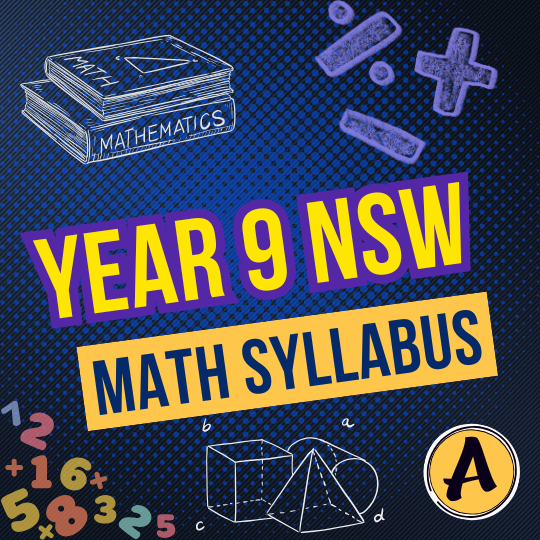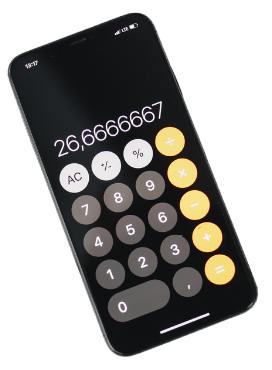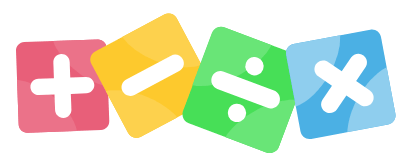Year 9 Maths NSW Curriculum Topics
Term 1, Year 9 Maths NSW
Equations
Solving and verifying equations, including multi-step and algebraic manipulation.
2D Spatial Relations: Geometrical Representations
Working with shapes on the Cartesian plane, nets, and diagrams.
2D Spatial Relations: Working with Triangles
Applying Pythagoras’ theorem.
Using trigonometric ratios (sine, cosine, tangent).
Exploring similarity and congruence
Term 2, Year 9 Maths NSW
2D Spatial Relations: Triangles (continued)
More advanced trigonometry, including angles of elevation/depression.
3D Spatial Relations: Prisms & Cylinders
Surface area and volume formulas.
Applications in real-life contexts.
Multiplicative Relationships: Index Laws
Simplifying expressions using indices.
Negative indices and scientific notation
Term 3, Year 9 Maths NSW
Linear Relationships: Financial Mathematics
Simple and compound interest.
Budgeting, loans, and real-life finance applications.
Linear Relationships: Constant Rates of Change
Gradient as rate of change.
Graphing linear relationships.
Connecting algebra and graphs
Term 4, Year 9 Maths NSW
Uncertainty: Making Predictions
Probability concepts.
Using sample space and experimental probability.
Uncertainty: Making Decisions
Data collection and analysis.
Statistical reasoning for real-world decision-making
Assessment in Year 9
Students complete four formal tasks, each worth 25% of the overall grade
Task 1 (Term 1, Week 10) – Project
Focus: Equations & Geometry (2D Spatial Relations).
Task 2 (Term 2, Week 6) – Exam
Focus: Triangles, 3D Spatial Relations, Index Laws.
Task 3 (Term 3, Week 6) – Exam
Focus: Financial Mathematics, Linear Relationships.
Task 4 (Term 4, Week 5) – Exam
Focus: Probability & Statistics (plus review of Terms 1–3).
💡 In some schools, Students are allowed to bring a handwritten double-sided A4 reference sheet. They must use an approved calculator for all exams
Introduction to Year 9 Maths NSW Syllabus
Year 9 marks a crucial stage in secondary schooling. Students are now well into Stage 5 (Years 9–10) of the NSW Mathematics curriculum, which builds on Stage 4 knowledge and prepares them for senior courses and the HSC.
By Year 9, maths becomes more connected to real-world applications — finance, probability, data, and algebraic modelling all feature strongly. Parents often ask: “Is Year 9 maths harder than Year 8?” or “What topics do they cover in Year 9?” This article breaks it down clearly, term by term. This stage can feel overwhelming at first, but with the right guidance and practice, students can develop strong foundations that will support their success throughout high school.
Key Skills Developed in Year 9 Maths
Algebraic reasoning and problem-solving.
Application of trigonometry and geometry in real contexts.
Strong understanding of finance (interest, budgeting).
Graphing and interpreting linear relationships.
Probability and data analysis to inform decisions.
Conclusion
Year 9 maths in NSW covers an exciting mix of algebra, geometry, finance, and probability. Structured assessments and a strong focus on problem-solving help students develop the skills they’ll need for senior school and beyond.
If your child needs extra support, explore our Year 9 practice resources and tutoring programs at Aussie Math Tutor NSW.
Frequently Asked Questions for Year 9 Maths NSW syllabus(FAQs)
Is Year 9 Maths Hard?
Year 9 Maths can feel hard at first because it deals with topics such as Trigonometry, Number Plane, Algebra, Equations, Word Problems, Linear Relationships, Finance, Percentages, and Probability.
If a student’s basics are weak, these gaps can make learning new concepts more difficult.
However, with regular practice and support, most students adapt well and gain confidence over time.
Do Year 9 students do algebra?
Yes! In Year 7 Maths, students deal with the following topics in algebra:
Equations (direct algebra).
Indices (laws and scientific notation).
Linear relationships (graphs & gradient).
Geometry & measurement (using algebra in trigonometry and formulas).
Financial maths (interest formulas).
What is the hardest topic in Year 9 maths?
Many students in Year 9 Maths find algebra challenging. Others struggle with the number plane and 3D shapes such as prisms and pyramids.
When should I consider getting a tutor for my Year 9 child?
Many parents notice early red flags when their child begins to struggle with maths. From our experience, the most common warning signs include:
Not knowing which topics they are studying
Simply copying work from the board without understanding
Consistently scoring lower marks than usual
Becoming upset or even crying when faced with maths tasks
Avoiding maths topics whenever possible
Losing confidence in their abilities
Struggling with basic operations (addition, subtraction, multiplication, division)
In more serious cases, falling 1–2 years behind the rest of the class
These struggles often build up quietly, but with early support and intervention—such as targeted tutoring—students can regain confidence, close gaps, and get back on track.
Is Year 9 maths harder than Year 8?
Yes, because it introduces more formal algebra and abstract reasoning, but the progression is gradual. The topics can feel overwhelming at first, but with the right practice and guidance, students build confidence and develop stronger problem-solving skills.
What are the Assessments for Year 9 NSW students?
The assessments change from school to school. Most of the schools may follow the following:
Task 1 (Term 1, Week 10) – Project: Focus: Equations & Geometry (2D Spatial Relations).
Task 2 (Term 2, Week 6) – Exam: Focus: Triangles, 3D Spatial Relations, Index Laws.
Task 3 (Term 3, Week 6) – Exam: Focus: Financial Mathematics, Linear Relationships.
Task 4 (Term 4, Week 5) – Exam: Focus: Probability & Statistics (plus review of Terms 1–3).
What math level should a 14-year-old be in?
A 14-year-old is generally in Year 9. Students in Year 7 should confidently handle algebra, percentages, and geometry. The syllabus ensures they reach this level.
How can everyday activities reinforce Year 9 Maths concepts?
Instead of teaching maths only as theory or “schoolwork,” it’s more effective to show students how maths is used in everyday life. Practical examples make learning meaningful. For instance, students can:
Calculate fares and choose time-efficient routes to school or the park
Use ratios while cooking recipes
Create a budget for chocolates or treats
Track fitness data such as steps, distance, or calories
These real-world activities not only make maths more engaging but also help students understand why it matters.
What are the best online tools or resources for Year 9 Maths practice?
There are many platforms that provide quizzes, interactive lessons, worksheets, and practical examples aligned with the NSW curriculum. One of the most trusted resources is Aussie Math Tutor NSW, which combines official NSW textbooks, past exam papers, NAPLAN material, thorough research, and expert input from NSW syllabus specialists to create high-quality learning resources.










